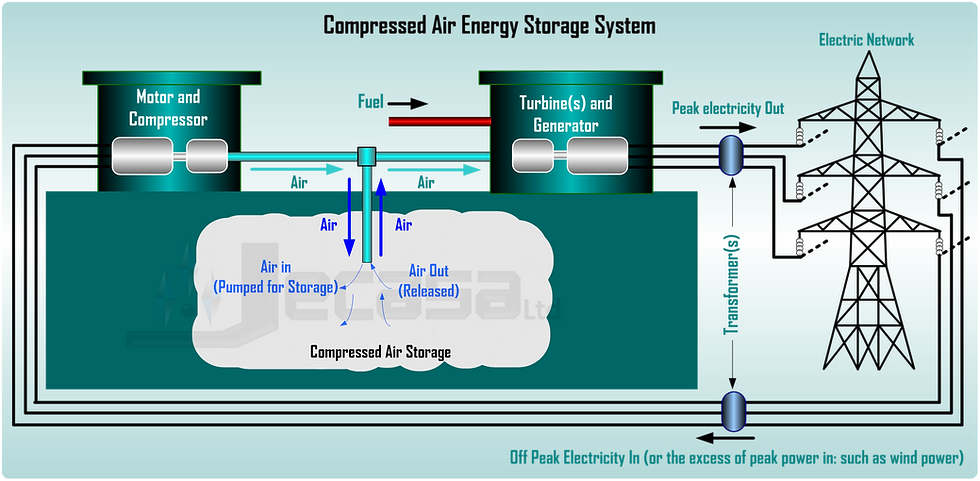Pumped Hydro Storage
- Dr Carmona Sanchez

- Jul 1, 2022
- 2 min read
Updated: Aug 7, 2022
Visit our full list of blog posts here.
Fig. 1: A general topology of a PHS system.
This diagram is available in our store in PPTX (PowerPoint) format, click here or the image!
Fig. 1 shows a general topology of a Pumped Hydro Storage (PHS) system. These types of storage system collect water from creeks and/or rivers and store it in an upper reservoir (commonly under off–peak demand). Therefore, the energy is stored as potential energy. The potential energy is transformed into electrical energy in the same way as is done in traditional hydro power plants: the water goes through a turbine which is connected to a generator. The energy stored is most commonly used to meet peak demands [Wagner and Mathur, 2011]. The 1,730 MW Dinorwig pumped hydro storage system in the UK is an example of a large scale application of this type of energy storage systems (Table 1) [DTI, 2006].
Table 1: Largest Pumped Hydro Power Plants in the World (adapted from [Wagner and Mathur, 2011]).
Pumped Hydro Power Satiation Name | Country | Capacity (MW) – Turbine Power |
Kannagawa Pumped Storage (to be finished at 2016) | Japan | 2,820 |
Bath County | USA | 2,730 |
Robert Moses Niagara Hydroelectric Power Station | USA | 2,520 |
Guangzhou Pumped Storage Power Station I + II | China | 2,400 |
Huizhou Hydroelectric Power Station | China | 2,400 |
Dneister Pumped Storage Plant (in construction) | Ukraine | 2,270 |
Okutataragi Pumped Storage Power Station | Japan | 1,940 |
Ludington Pumped Storage Power Plant | USA | 1,870 |
Tianhuangping Pumped Storage Power Plant | China | 1,840 |
Grand Maison | France | 1,800 |
Dinorwig Power Station | UK (Wales) | 1,730 |
Raccoon Mountain Pumped Storage Plant | USA | 1,600 |
Kazunogawa Hydroelectric Power Plant | Japan | 1,600 |
Mingtan Power Plant | Taiwan | 1,600 |
Tumut 3 | Australia | 1,500 |
Goldisthal | Germany | 1000 |
Vianden | Luxemburg | 1000 |
This energy storage process implies some losses. Electrical power is needed to pump the water into the upper reservoir; therefore, losses due to electrical and mechanical equipment are present. When the water flows down, again losses are present as well. About 20% of the energy used in the whole process is lost, and about 80% of the energy is recovered [Wagner and Mathur, 2011]. Also, this type of energy storage system needs long construction times and high capital costs for both the plant and transmission lines (since it depends on specific geographic locations which are commonly far away from consumption centres) [PIER, 2011].
However, PHS seems to be the best choice of energy storage since, similar to common hydro power stations, it has the ability for almost instantaneous starting and stopping. Therefore, this type of energy storage is a good choice to support peak demands. Also, its operation, generation cost and maintenance are lower than other type of energy storage. It also has a high efficiency (about 80%) [Wagner and Mathur, 2011] compared with other energy storage technology. Table 1 shows the largest PHS systems in the world.
You may be interested in the following (these are promotional links):




Comments